The 101st Armored Battlegroup
The 101st Armored Battlegroup, the famous "Rucker's 101st," is a diverse and powerful Imperial Guard formation hailing from the Fortis Sector.
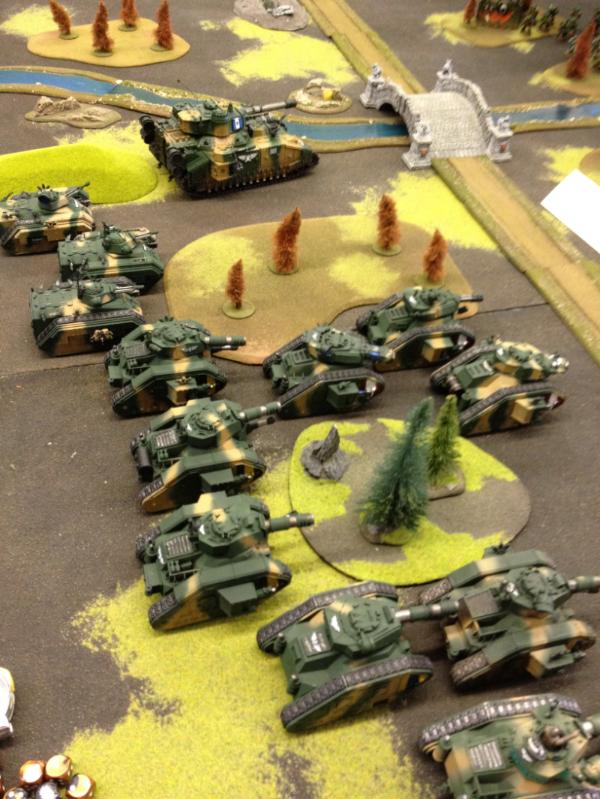
Background: The Fortis Sector and Rucker's World
The Fortis Sector is one of the more prosperous and settled in the Imperium. Largely spared from the large scale invasions of Xenos and the forces of the Ruinous Powers that have ravaged so much of the Imperium, the sector has nonetheless profited from the trade generated by large-scale combat in neighboring sectors. Nestled in the center of the Fortis Sector is Rucker’s World, which serves as the sector’s political and economic hub. The current Imperial Governor of Rucker’s World, Lord Ruckdog, has served in that position for almost two centuries. In that time, he has gained considerable influence and power within the higher levels of the Imperial bureaucracy, more than certain elements of the Inquisition are entirely comfortable with, if the rumors are to be believed.
Some of these rumors stem from the manner in which Lord Ruckdog has gone about fulfilling his tithing obligations. All Imperial worlds are required to tithe units for the Imperial Guard, and Rucker’s World is no exception. However, Lord Ruckdog has used the considerable wealth and power of his position to create a number of well-equipped fighting units that combine elements of various regiments into a self-contained combined arms force. While such battlegroups are not uncommon in the Imperial Guard, the ones arising from Rucker’s World are unique in that they tend to be semi-permanent forces rather than ad-hoc formations created to accomplish a specific mission. Furthermore, Lord Ruckdog has reportedly used his connections within both the Adeptus Mechanicus and the Administratum to ensure that “his” battlegroups always have dedicated interstellar transport available, as well as influencing their assignments. Given all of this, it is easy to see why the Inquisition would be concerned about the existence of such formations; they smack of a private, mobile army that could possibly be put to traitorous ends. However, thus far Lord Ruckdog is far too well connected and popular for the Inquisition to move against him openly.
The 101st Armored Battlegroup is one of Lord Ruckdog’s battlegroups. Since this formation consists primarily of units hailing from Rucker’s World, it is often referred to simply as “Rucker’s 101st” by Guardsmen and their officers alike. The 101st is typical of Lord Ruckdog’s battlegroups, containing all the elements of a combined force including armored, artillery, mechanized infantry, and standard infantry companies, and several other supporting scout, supply, and engineer platoons. The 101st can also count on aerial transport and close air support from Imperial Navy aircraft supplied by the Fortis Sector’s battlefleet, Battlegroup Fortitas. All of these units are transported by the Orion-class mass conveyor Aegis Imperialis. Additional forces, in the form of naval escort and bombardment, or even Titan Legio support, have been assigned from time to time.
Assigned Units
As of 399M41, Rucker’s 101st Armored Battlegroup consisted of the following forces:
76th Armored Regiment, 2nd Company
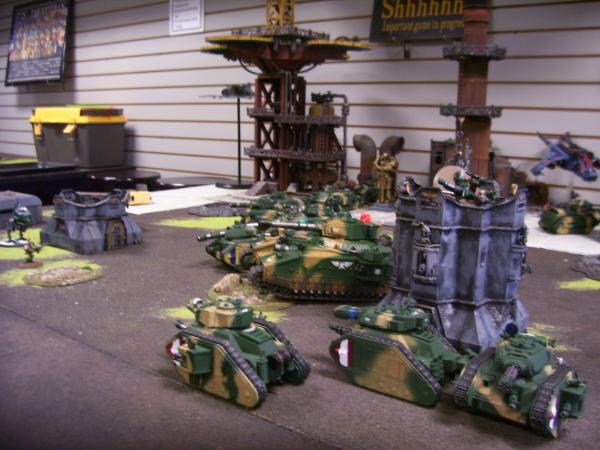
Composition:
The 101st’s armored component consists primarily of the 10 Leman Russ tanks of the 2nd/76th, which are organized as one command tank with 3 platoons of 3 tanks each. The exact composition of each platoon tends to vary somewhat due to the piecemeal replacement of combat losses, but in general the first and second platoons consist of standard LRBT variants, while the third platoon contains tanks based off the Demolisher chassis. In addition to this core force of 10 tanks, the 2nd/76th can also call on the support of a Superheavy platoon. At the moment, this platoon consists of only the venerable Baneblade Rolling Thunder, but there are outstanding requisitions for additional superheavy tanks.
Markings:
In accordance with the officially adopted Munitorum standards for Rucker’s World forces, each platoon in the tank company is marked with three vertical stripes in two colors. Tank numbering is for tactical purposes only, and consists of 3 numbers; the first digit is the company number, the second digit is the platoon number, and the final digit is the tank number within that platoon. The command tank uses a zero for its second digit.
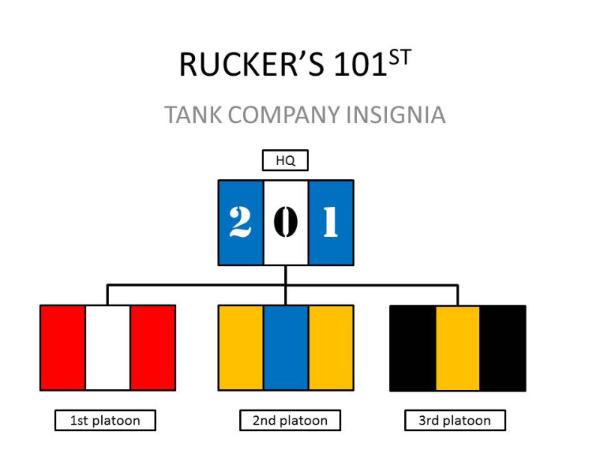
71st Mechanized Regiment, 1st Company
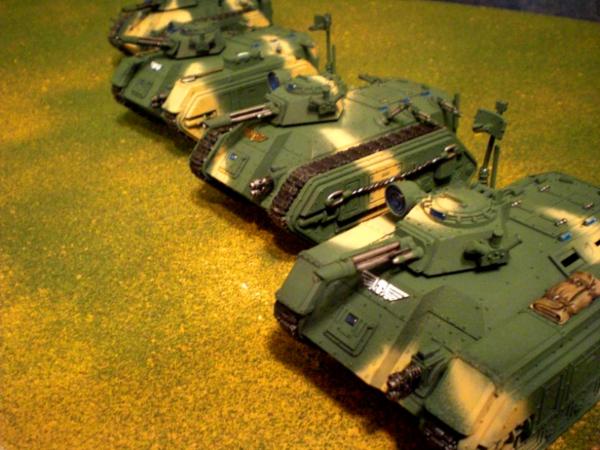
Composition:
The 1st/71st consists of a full infantry company mounted in Chimera transports. Nominally, this is a minimum of 10 vehicles, for in addition to the company command squad, there are three infantry platoons that consist of a platoon command squad and two line squads. Each infantry squad is equipped with a squad heavy weapon, often an Autocannon. More specialized heavy weapons, such as las cannons or missile launchers, are typically fielded by weapons support platoons mounted in their own Chimeras. Thus, the actual number of vehicles used by the 1st/71st can far exceed the nominal 10.
Markings:
To differentiate the mechanized infantry markings from those of the tank company, the Chimeras are marked with two vertical stripes of differing colors, generally mirroring the colors used by the armored company. Tank numbering follows a similar scheme as the one used by the tank company. Interestingly, this means that the 1st/71st’s company command vehicle’s number “101” corresponds to the battlegroup’s number, making this Chimera the unofficial symbol of the whole Battlegroup. The troops in each platoon wear the same two vertical stripes as their vehicle on the left shoulder guard of their flak armor, while the vehicle’s number appears in white on the right shoulder.
302nd Artillery Regiment, 8th Company

Composition:
Artillery support for Rucker’s 101st is supplied by the 8th/302nd Artillery Company (Reinforced). The reinforced designation comes from the fact that this formation actually consists of no less than 5 artillery platoons, as well as a dedicated ammunition supply company and a command Chimera. Furthermore, each platoon may actually consist of up to 5 vehicles. First Platoon is equipped with Griffon mortar carriers, while Second and Third Platoons are equipped with Basilisk mechanized howitzers. Fourth Platoon is a dedicated siege unit, equipped with Manticore rocket launchers and siege mortars. The Fifth Platoon is a dedicated anti-air artillery platoon, equipped with Hydra flak tanks.
Markings:
The identifying markings for the artillery company consist of a diagonally divided two-color field, with each company having a separate color combination. Vehicle numbering is as described above.
65th Infantry Regiment, 1st and 2nd Companies
Composition:
While the mechanized and armored companies are vital for the kind of maneuver warfare favored by the Rucker’s World military high command, there will always be a need for light infantry to consolidate gains and hold territory. This role is filled in the Rucker’s 101st by two full companies of the 65th Infantry Regiment. Each company consists of its own command squad and 5 platoons of infantry. The standard platoon consists of a command squad, 4 infantry squads, and several supporting weapons squads under the direct tactical control of the platoon commander. Together, the 1st/65th and 2nd/65th comprise more than 600 Guardsmen. While these companies are not rated as mechanized, they do nonetheless have access to a number of “soft” transport vehicles, such as the ubiquitous Cargo 6 and Cargo 8 cargo trucks. Additionally, each company maintains a motor pool containing a handful of Chimeras and Salamanders for the use of the company and platoon commanders on an as-needed basis.
Markings:
Each infantry platoon has an identifying color, as follows: 1st Platoon, Red; 2nd Platoon, Yellow; 3rd Platoon, Grey; 4th Platoon, Green; 5th Platoon, Black. The left shoulder guard of each Guardsman’s flack armor is pained in that color. In addition, the Company Command squad uses Blue as their identifying color, with a white skull insignia. Each Guardsman wears a 3-digit number on their right shoulder, in white. The first digit indicates the company number, the second indicates the platoon number, and the 3rd indicates the squad number. Platoon commands use the number zero for the squad number, while company commands use a single digit to indicate their company. These colors and numbers are to be applied to any vehicles that are assigned to a particular squad for greater than 5 days.
Scout Platoon
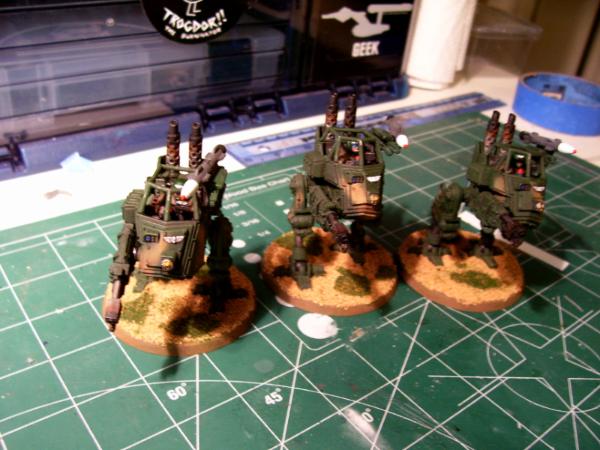
Composition:
The scout platoon is comprised of several squadrons of Sentinels, as well as a squadron of Hellhound light tanks. Additional light units, such as motorcycle troops or even horse cavalry may be formed from time to time depending on the tactical situation; due to the high attrition rate these forces endure, their exact composition is not fixed. Likewise, the platoon is not from a standing regiment, but rather recruits its members from within the other regiments assigned to the Battlegroup. These light forces are heavily engaged in duties ranging from scouting for the armored and mechanized forces, to supporting infantry units, to escorting vital supply convoys.
Markings:
Each squadron is marked with a two-color insignia consisting of an “X” over a field of a contrasting color. The command vehicle consists of a white X on a blue background. Vehicle numbering consists of a two digit scheme (the company number is omitted). The first digit is the squadron numCatele the second number is the vehicle’s number within the squadron. The platoon commander’s vehicle is denoted with a white skull insignia instead of a number.
131st Imperial Navy Tactical Wing
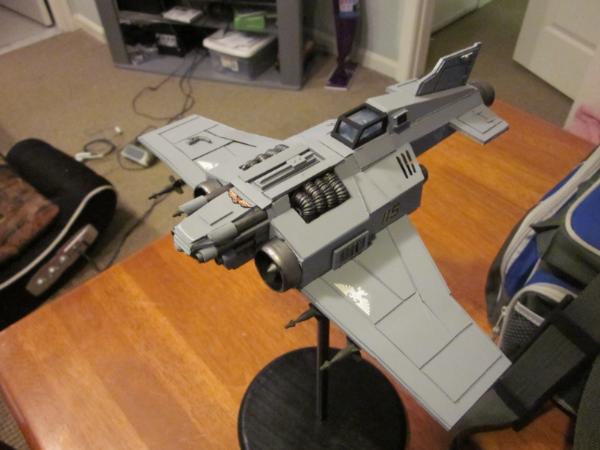
The 131st Tac Wing, “The Wildcats” is a mixed air wing that provides the Rucker’s 101st with close air support, transport, and supply. The wing flies a number of different aircraft, including the venerable Thunderbolt and hard-hitting Avenger, as well as more utilitarian craft such as the Valkyrie and its gunship cousin the Vendetta. This is in addition to a number of other cargo and transport craft, such as Aquila landers and Arvus shuttles. While the tactical command of these ships falls under the Imperial Navy, company and platoon commanders are provided extensive training on the coordination of air strikes on enemy targets to ensure the smooth integration of air power into the formation’s battle plan.
The Aegis Imperialis
This enormous Orion-class conveyer serves as the battlegroup’s mobile logistics base as well as its transport to the war zone. It contains cavernous holds for the battlegroup’s supplies and equipment, billets and training areas for its personnel, workshops for the maintenance of its vehicles, and launch bays for both the large orbital landing craft and the tactical aircraft of the 131st TAC Wing. However, these facilities do not do not account for the entirety of the conveyer’s vast interior. Entire holds large enough to swallow squadrons of Baneblades are completely walled off from the rest of the ship, their only access points under continuous watch from members of Lord Ruckdog’s personal guard. Rumors abound about what might be hidden away in these areas; some say they are used to smuggle illicit war booty of ancient or even xenos origin, while others say that they are nothing more than part of the Govenor’s secret trade network for more mundane commodities such as precious metals and fine sacra. The only thing that is certain is that whatever is going on, it is happening with the tacit approval of the Mechanicus, as nothing can enter or leave the enormous ship without their knowledge.
Why I Started This Army
I started into 40k when I realized that Battlefleet Gothic opponents were getting harder to come by. I naturally gravitate to the "average joe" faction in just about any fantasy or sci-fi setting; I always play Terrans in Star Craft, for instance. So, the Imperial Guard seemed to be a natural fit. That, and TANKS! I'm very much into mechanized warfare, and the Imperal Guard has that in spades. Another inspiration for playing Imperial Guard are several Black Library books I was reading at about the same time, notably the Guant's Ghosts series and the Imperial Guard Omnibus. My overall concept for my army is that it is a relatively elite (to the extent that a regular Guard army can be!) formation that is well equipped and fairly mobile; in this sense, they are somewhat analogous to the present day USMC, which has the capability to deploy combined arms formations rapidly.